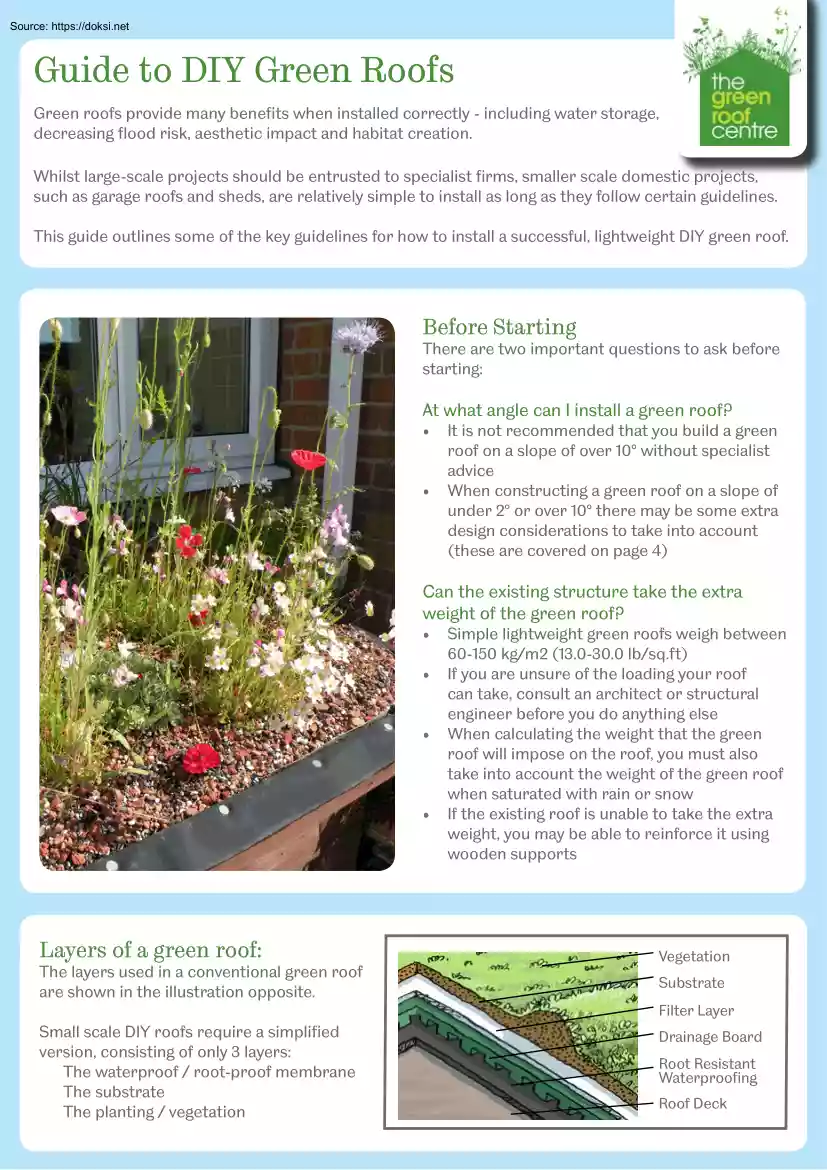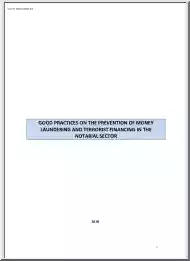Please log in to read this in our online viewer!

Please log in to read this in our online viewer!
No comments yet. You can be the first!
What did others read after this?
Content extract
Guide to DIY Green Roofs Green roofs provide many benefits when installed correctly - including water storage, decreasing flood risk, aesthetic impact and habitat creation. Whilst large-scale projects should be entrusted to specialist firms, smaller scale domestic projects, such as garage roofs and sheds, are relatively simple to install as long as they follow certain guidelines. This guide outlines some of the key guidelines for how to install a successful, lightweight DIY green roof. Before Starting There are two important questions to ask before starting: At what angle can I install a green roof? • • It is not recommended that you build a green roof on a slope of over 10° without specialist advice When constructing a green roof on a slope of under 2° or over 10° there may be some extra design considerations to take into account (these are covered on page 4) Can the existing structure take the extra weight of the green roof? • • • • Layers of a green roof: The
layers used in a conventional green roof are shown in the illustration opposite. Small scale DIY roofs require a simplified version, consisting of only 3 layers: The waterproof / root-proof membrane The substrate The planting / vegetation Simple lightweight green roofs weigh between 60-150 kg/m2 (13.0-300 lb/sqft) If you are unsure of the loading your roof can take, consult an architect or structural engineer before you do anything else When calculating the weight that the green roof will impose on the roof, you must also take into account the weight of the green roof when saturated with rain or snow If the existing roof is unable to take the extra weight, you may be able to reinforce it using wooden supports Vegetation Substrate Filter Layer Drainage Board Root Resistant Waterproofing Roof Deck Waterproof Layer/Root-proof Membrane • Typical sheds will already have an asphalt or bitumen felt layer of waterproofing. Green roofs require an additional layer of waterproof material
which is also root resistant. Ideally this will be in the form of a single sheet to cover the whole area. • Heavy-duty pond liner from a local garden centre is ideal e.g 1mm EDPM. This can be fixed with a strong mastic sealant TIP: Mark outlets/penetrations before installing so they can be easily located and cut out at a later stage. Drainage • Excess water should always be able to escape from the roof. Drainage outlets should be cut into the containment frame to allow water to flow into the roof’s guttering. • Drainage is very important; the roof must not be overloaded so it is vital that outlets are kept clear. Use a layer of pebbles to avoid blockages; pebbles can also be used at the roof edge to prevent vegetation establishing. Substrate • The depth of the substrate dictates the vegetation that will grow there. Most DIY roofs have a depth of 70 – 200mm • The substrate used needs to be light-weight and be low in nutrients. Avoid using just common garden
soils such as topsoil and peat as they are very heavy when wet, have a high organic content and will encourage undesirable vegetation to establish. • If you decide to mix your own substrate a good ratio to use is 70-80% inorganic material (crushed brick, expanded clay) to 20-30% organic material. A common mixture is 70% crushed recycled brick to 30% composted green waste. Maintenance The maintenance requirement of a DIY roof is usually minimal. The following checks need to be made 1-2 times a year to ensure the green roof’s longevity: • • • • • In dry seasons ensure plants are watered especially in the first year of planting to ensure good coverage After the first year water only during severe drought conditions of 6 or more weeks Ensure drainage outlets remain clear and free from vegetation Ensure gravel margins are free from unwanted vegetation If bare areas occur on the roof these should be re-planted with seeds, plug plants or cuttings Planting The most
exciting part of the green roof is the planting! You can tailor your planting to attract specific species of plants and wildlife or reflect the local seed bank. Many seed suppliers now offer green roof seed mixes specially formulated using plants that can cope with the extreme weather conditions associated with an elevated location. Vegetation can be applied several ways: 1. Pre-vegetated mats or blankets – These are ordered to site in rolled up mats and are installed in a similar way to turf. They usually consist of sedums or wildflowers 2. Direct planting of plant cuttings, plug plants (more established plants) or seeding About the plants: Sedums • Sedums are alpine plants used to living in harsh elevated conditions. They require little maintenance and maintain coverage all year round. The flowers also attract a wide range of insect species in the summer months. Wildflowers • Wildflowers can survive in low nutrient substrates and provide a more diverse planting
opportunity. The meadow-flowers best adapted for green roof use are those associated with limestone and chalk environments such as Cows Slip, lady’s bedstraw, rockrose, harebell, hawkweeds and thyme. Tips for planting • • • Avoid monocultures as the success of establishing a self-maintaining plant community is increased when a mix of species is used The steeper the slope of the roof, the more care should be taken to ensure plants located near the top of the roof are most drought-tolerant as they will get less water To reduce the need for watering as the plants establish, a green roof should be planted up in the spring or autumn Tony’s Bird Box Nigel’s Shed James’s Shed Design Considerations A frame should be built around the perimeter of the roof, out of rot resistant materials. This will ensure the green roof materials remain contained. Ensure that the frame does not block water from draining off the roof. Be careful to ensure the waterproofing is not
damaged at this stage If there is any chance of plants getting into the building and compromising the building’s structure, a gravel margin 300mm wide should be placed around the edge of the roof and anything penetrating the roof surface. The gravel margin will also ensure unwanted vegetation does not establish at the roof’s edge. If the slope of the roof is over 20° you will need to ensure that the green roof does not slip. Slippage can be prevented through the use of wood or a metal grid laid on top of the root-proof membrane in a ‘chequerboard’ pattern. Nigel’s Shed: example of a ‘chequerboard’ pattern Jeff’s Garage: example of a gravel margin PLEASE NOTE Specialist support and Building Regulations must be consulted before greening roofs over occupied buildings, or those attached to occupied buildings. It is advisable to contact your local council’s building control department before proceeding, especially if the roof you are constructing is on a boundary with
another property, or if your project involves structural changes. Environmental Considerations In order to maximise the green roof’s environmental credentials a few things need to be taken into account: • Avoid using chemicals and fertilizers on the roof as they can leach out in runoff and pollute watercourses • Try to source green roof materials from local suppliers to reduce transport miles • Consider using recycled materials from a builders merchants to create substrate Health & Safety Remember to always take extra care when working off the ground For inspiration and information, to find a green roof supplier in your area, or to submit your own project for inclusion in our DIY gallery, visit our website: www.thegreenroofcentrecouk
layers used in a conventional green roof are shown in the illustration opposite. Small scale DIY roofs require a simplified version, consisting of only 3 layers: The waterproof / root-proof membrane The substrate The planting / vegetation Simple lightweight green roofs weigh between 60-150 kg/m2 (13.0-300 lb/sqft) If you are unsure of the loading your roof can take, consult an architect or structural engineer before you do anything else When calculating the weight that the green roof will impose on the roof, you must also take into account the weight of the green roof when saturated with rain or snow If the existing roof is unable to take the extra weight, you may be able to reinforce it using wooden supports Vegetation Substrate Filter Layer Drainage Board Root Resistant Waterproofing Roof Deck Waterproof Layer/Root-proof Membrane • Typical sheds will already have an asphalt or bitumen felt layer of waterproofing. Green roofs require an additional layer of waterproof material
which is also root resistant. Ideally this will be in the form of a single sheet to cover the whole area. • Heavy-duty pond liner from a local garden centre is ideal e.g 1mm EDPM. This can be fixed with a strong mastic sealant TIP: Mark outlets/penetrations before installing so they can be easily located and cut out at a later stage. Drainage • Excess water should always be able to escape from the roof. Drainage outlets should be cut into the containment frame to allow water to flow into the roof’s guttering. • Drainage is very important; the roof must not be overloaded so it is vital that outlets are kept clear. Use a layer of pebbles to avoid blockages; pebbles can also be used at the roof edge to prevent vegetation establishing. Substrate • The depth of the substrate dictates the vegetation that will grow there. Most DIY roofs have a depth of 70 – 200mm • The substrate used needs to be light-weight and be low in nutrients. Avoid using just common garden
soils such as topsoil and peat as they are very heavy when wet, have a high organic content and will encourage undesirable vegetation to establish. • If you decide to mix your own substrate a good ratio to use is 70-80% inorganic material (crushed brick, expanded clay) to 20-30% organic material. A common mixture is 70% crushed recycled brick to 30% composted green waste. Maintenance The maintenance requirement of a DIY roof is usually minimal. The following checks need to be made 1-2 times a year to ensure the green roof’s longevity: • • • • • In dry seasons ensure plants are watered especially in the first year of planting to ensure good coverage After the first year water only during severe drought conditions of 6 or more weeks Ensure drainage outlets remain clear and free from vegetation Ensure gravel margins are free from unwanted vegetation If bare areas occur on the roof these should be re-planted with seeds, plug plants or cuttings Planting The most
exciting part of the green roof is the planting! You can tailor your planting to attract specific species of plants and wildlife or reflect the local seed bank. Many seed suppliers now offer green roof seed mixes specially formulated using plants that can cope with the extreme weather conditions associated with an elevated location. Vegetation can be applied several ways: 1. Pre-vegetated mats or blankets – These are ordered to site in rolled up mats and are installed in a similar way to turf. They usually consist of sedums or wildflowers 2. Direct planting of plant cuttings, plug plants (more established plants) or seeding About the plants: Sedums • Sedums are alpine plants used to living in harsh elevated conditions. They require little maintenance and maintain coverage all year round. The flowers also attract a wide range of insect species in the summer months. Wildflowers • Wildflowers can survive in low nutrient substrates and provide a more diverse planting
opportunity. The meadow-flowers best adapted for green roof use are those associated with limestone and chalk environments such as Cows Slip, lady’s bedstraw, rockrose, harebell, hawkweeds and thyme. Tips for planting • • • Avoid monocultures as the success of establishing a self-maintaining plant community is increased when a mix of species is used The steeper the slope of the roof, the more care should be taken to ensure plants located near the top of the roof are most drought-tolerant as they will get less water To reduce the need for watering as the plants establish, a green roof should be planted up in the spring or autumn Tony’s Bird Box Nigel’s Shed James’s Shed Design Considerations A frame should be built around the perimeter of the roof, out of rot resistant materials. This will ensure the green roof materials remain contained. Ensure that the frame does not block water from draining off the roof. Be careful to ensure the waterproofing is not
damaged at this stage If there is any chance of plants getting into the building and compromising the building’s structure, a gravel margin 300mm wide should be placed around the edge of the roof and anything penetrating the roof surface. The gravel margin will also ensure unwanted vegetation does not establish at the roof’s edge. If the slope of the roof is over 20° you will need to ensure that the green roof does not slip. Slippage can be prevented through the use of wood or a metal grid laid on top of the root-proof membrane in a ‘chequerboard’ pattern. Nigel’s Shed: example of a ‘chequerboard’ pattern Jeff’s Garage: example of a gravel margin PLEASE NOTE Specialist support and Building Regulations must be consulted before greening roofs over occupied buildings, or those attached to occupied buildings. It is advisable to contact your local council’s building control department before proceeding, especially if the roof you are constructing is on a boundary with
another property, or if your project involves structural changes. Environmental Considerations In order to maximise the green roof’s environmental credentials a few things need to be taken into account: • Avoid using chemicals and fertilizers on the roof as they can leach out in runoff and pollute watercourses • Try to source green roof materials from local suppliers to reduce transport miles • Consider using recycled materials from a builders merchants to create substrate Health & Safety Remember to always take extra care when working off the ground For inspiration and information, to find a green roof supplier in your area, or to submit your own project for inclusion in our DIY gallery, visit our website: www.thegreenroofcentrecouk




